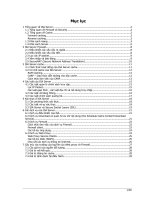Module 001 essential security terminologies
Bạn đang xem bản rút gọn của tài liệu. Xem và tải ngay bản đầy đủ của tài liệu tại đây (335.43 KB, 12 trang )
Engineered by Hackers. Presented by Professionals.
Essential Security Terminologies
Module 00
H c vi n Công Ngh Thông Tin Bách ọ ệ ệ
Khoa
Essential Security Terminologies
Authentication: is the process of
determining “who are you ?”
Access Control: ensures that resources are only
granted to those users who are entitled to them.
Access Control List (ACL): A mechanism that
implements access control for a system resource
by listing the identities of the system entities that
are permitted to access the resource
Single Sign-On: allow users to get access to
multiple computers and applications without
learning many different passwords
H c vi n Công Ngh Thông Tin Bách ọ ệ ệ
Khoa
Essential Security Terminologies
Authorization:
Authentication asks the question of "Who are
you?" whereas Authorization addresses the
question of "Are you allowed to do that?“
Availability:
Availability is the need to ensure that the
business purpose of the system can be met
and that it is accessible to those who need
to use it.
H c vi n Công Ngh Thông Tin Bách ọ ệ ệ
Khoa
Essential Security Terminologies
Confidentiality: Confidentiality is the need to ensure that
information is disclosed only to those who are authorized to
view it.
Encryption: Cryptographic transformation of data (called "plaintext")
into a form (called "cipher text") that conceals the data's original meaning
to prevent it from being known or used.
Decryption: Decryption is the process of transforming an encrypted
message into its original plaintext.
Security Policy: A set of rules and practices that specify or regulate how
a system or organization provides security services to protect sensitive and
critical system resources.
Auditing: Auditing is the information gathering and analysis of assets to
ensure such things as policy compliance and security from vulnerabilities.
H c vi n Công Ngh Thông Tin Bách ọ ệ ệ
Khoa
Essential Security Terminologies
Integrity: Integrity is the need to ensure that information
has not been changed accidentally
Certification Authority (CA): A Certificate Authority
(CA) is an organization that issues and manages security
credentials and public keys for message encryption and
decryption
•
This is an essential part of a public key infrastructure (PKI)
H c vi n Công Ngh Thông Tin Bách ọ ệ ệ
Khoa
Essential Security Terminologies
Vulnerability: is a weakness which allows
an attacker to reduce a system's information
assurance
Threat: A potential for violation of security,
which exists that could breach security and
cause harm.
H c vi n Công Ngh Thông Tin Bách ọ ệ ệ
Khoa
Essential Security Terminologies
Attack
Reconnaissance: Reconnaissance is the phase of an
attack where an attackers finds new systems, maps out
networks, and probes for specific hosts, exploitable
vulnerabilities.
Packet sniffers: simply captures all of the packets of
data that pass through a given network interface
Ping sweeps: An attack that sends ICMP echo
requests ("pings") to a range of IP addresses
Port scans: A port scan is a series of messages sent
by someone attempting to break into a computer to
learn which computer network services, each
associated with a "well-known" port number
Internet information queries: can be used to
gather information for future attacks
H c vi n Công Ngh Thông Tin Bách ọ ệ ệ
Khoa
Essential Security Terminologies
Attack
Access Attacks: Access attacks exploit known
vulnerabilities in services as FTP services, and web
services… to gain entry to web accounts,
confidential databases, and other sensitive information
Password attack: refers to repeated attempts to
identify a user account, password, or both
Trust exploitation: An attacker uses privileges
granted to a system in an unauthorized way
Port redirection: that uses a compromised host to
pass traffic through a firewall that would otherwise be
blocked
H c vi n Công Ngh Thông Tin Bách ọ ệ ệ
Khoa
Essential Security Terminologies
Attack
Access Attacks: Access attacks exploit known
vulnerabilities in authentication services, FTP services,
and web services to gain entry to web accounts,
confidential databases, and other sensitive information
Man-in-the-middle attack: An attacker is
positioned in the middle of communications between
two legitimate entities in order to read or modify the
data that passes between the two parties
Buffer overflow: A program writes data beyond the
allocated buffer memory.
H c vi n Công Ngh Thông Tin Bách ọ ệ ệ
Khoa
Essential Security Terminologies
Attack
•
Denial of Service Attacks
DOS: intentionally overload computers and/or
networks with garbage traffic for the purpose of
preventing legitimate traffic from reaching its
destination
DDOS: are DoS attacks from multiple sources at the
same time.
H c vi n Công Ngh Thông Tin Bách ọ ệ ệ
Khoa
Essential Security Terminologies
Attack
•
Malicious software Attacks
Virus: is malicious software to execute a specific
unwanted function on a computer
Worm: Worm executes arbitrary code and installs
copies of itself in the memory of the infected
computer, which then infects other hosts
Backdoor: tool installed after a compromise to give
an attacker easier access to the compromised system
around any security mechanisms that are in place
Trojan: allow hackers to obtain sensitive data as well
as cause harm to your machine
Malware: A generic term for a number of different
types of malicious code.
H c vi n Công Ngh Thông Tin Bách ọ ệ ệ
Khoa
Essential Security Terminologies
Risk: threat with the level of vulnerability. It
establishes the likelihood of a successful attack
VPN: A VPN (Virtual Private Network) allows
secure communications over the public internet.
Firewall: system or group of systems that
enforces an access control policy between two
networks.
IDS: An IDS gathers and analyzes information
from various areas within a computer or a
network to identify possible security breaches
IPS: identify malicious activity, log information
about said activity, attempt to block/stop activity,
and report activity








